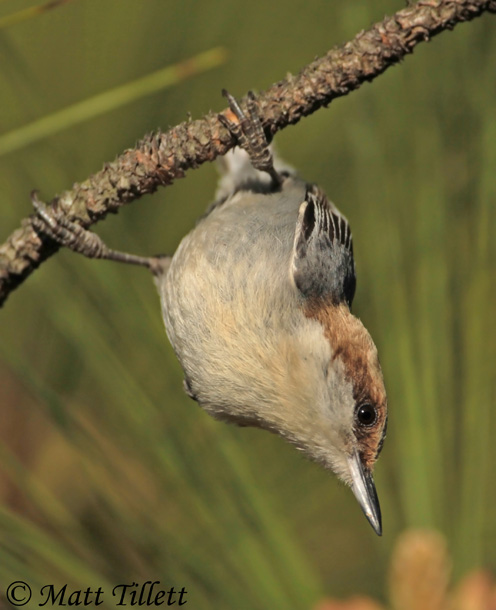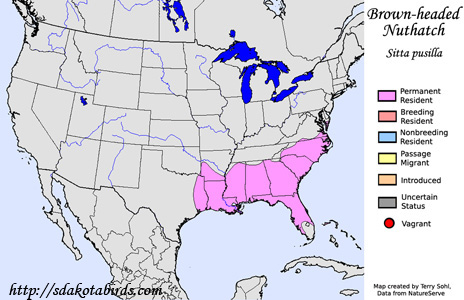| Length: 4.5 inches | Wingspan: 7.75 inches | Seasonality: Non-resident in South Dakota |
| ID Keys: Tiny size, brown cap, white underparts, bluish-gray upperparts | ||
 The
Brown-headed Nuthatch is a small nuthatch of pine forests in the
Southeastern United States. They are the ecological counterpart to the
Pygmy Nuthatch, found in the Western
United States, and are very similar in overall appearance. When
foraging, they can often be seen flying up to the mid-level of a tree,
working down the trunk head-first as they search for insects, and then
repeating the process with a nearby tree.
The
Brown-headed Nuthatch is a small nuthatch of pine forests in the
Southeastern United States. They are the ecological counterpart to the
Pygmy Nuthatch, found in the Western
United States, and are very similar in overall appearance. When
foraging, they can often be seen flying up to the mid-level of a tree,
working down the trunk head-first as they search for insects, and then
repeating the process with a nearby tree.
Habitat: Found in open pine forests of the southeastern U.S., or areas of pine mixed with deciduous trees.
Diet: Feeds on insects and spiders year-round when available. Will also feed on seeds, mostly seeds of pine trees, especially in the winter time.
Behavior: Forages by climbing over the trunk and major branches of trees, mostly pine trees, searching for insects. They also sometimes will fly out to capture insects in mid-air.
Nesting: The nest of a Brown-headed Nuthatch is a cavity in a dead tree, usually a pine, but they will also sometimes use deciduous trees, or even fence posts and telephone poles. They will use existing cavities built by other species, or will excavate their own, with both the male and female helping. The nesting cavity is filled with softer vegetative material such as grasses, feathers, and animal hair. The female lays between 4 and 6 eggs, with the female incubating them while the male brings her food. When the eggs hatch, both parents help to feed the young, who leave the nest after about two and a half weeks.
Song: Call is a crisp Kew-dee followed by a lower-pitched series of nasal-sounding notes.
Migration: Considered a permanent resident throughout their range. On rare occasions small numbers may wander north of their normal range.
Interactive eBird Map: Click to access an interactive eBird map for Brown-headed Nuthatch sightings
Similar Species: Most similar to the Pygmy Nuthatch, but the ranges of those two species do not overlap. Other nuthatch species (White-breasted Nuthatch, Red-breasted Nuthatch) are also similar in structure, but plumage differences are obvious.
Conservation Status: Populations of Brown-headed Nuthatch are stable and widespread. The IUCN lists the Brown-headed Nuthatch as a species of "Least Concern".
Further Information: 1) Everglades National Park - Species Profile - Brown-headed Nuthatch
2) Audubon Guide - Brown-headed Nuthatch
3) USGS Bird InfoCenter - Brown-headed Nuthatch
Photo Information: Photo taken by Matt Tillett - Taken at Auburn University fish ponds in Alabama - Licensed under Creative Commons Attribution 2.0 Generic License.
| Click below for a higher-resolution map |
 |
| South Dakota Status: Non-resident in South Dakota |
Additional Brown-headed Nuthatch Photos (Coming Soon!)
